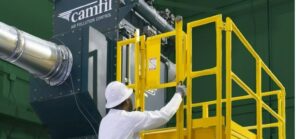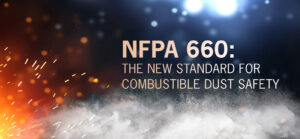Preventive dust collector maintenance is often ignored. A high-quality dust collector that’s been properly designed and installed for your specific operation should provide peace of mind that the air in your facility is safe to breathe. Additionally, it should offer reliable and trouble-free performance. However, this doesn't mean you can overlook its mechanics or servicing needs over its lifespan.
Regular preventative dust collector maintenance checks your system to help you identify and address potential issues before they escalate into more significant problems. Here are some crucial aspects to include in your system and performance inspection.
Monitoring Differential Pressure
We suggest daily tracking of differential pressure trends across the filters to ensure that the pressure stays within the limits set by the manufacturer. Adding a filter monitoring system to your dust collector will help you keep an eye on important functions and notify you when critical thresholds are reached. This aids in ensuring timely preventive maintenance. If you observe that the system's pressure has reached the manufacturer's prescribed differential pressure limit, it may be time to replace your filters.
Dust Collector Cleaning System Checks
You should inspect the filter pulse cleaning system daily to make sure it’s working properly. Any malfunction could signal an issue with the diaphragm and solenoid valves, which play a crucial role in regulating pulses and ensuring effective dust collector cleaning.
In your inspection, be sure to check the following elements:
- Solenoid valves: Verify that they're functioning correctly.
- Diaphragm valves: Inspect these for any signs of damage or failure.
- Controller settings and operation: Confirm that they're correct and functioning as expected.
- Electrical settings: Make sure they're set properly.
- Air pressure settings: Check that they're within the appropriate range.
- Filter regulator cleanout: Verify that it's clean and unobstructed.
- Airline leakage or clogs: Look out for any signs of leaks or blockages.
- Differential pressure numeric: Ensure it's within the prescribed limit.
- Air header tank moisture: Check for any presence of excess moisture.
- Compressed air connections: Inspect these for any signs of leaks or damage.
- Pulse pipe alignment: Make sure it's correctly aligned.
Filter and Media Inspection
We recommend conducting a comprehensive inspection of your filter cartridges and filter media when you see an unusual change in pressure drop across the filter media. Click here to watch a 1-minute video about pressure drop. Look for signs of wear and tear such as abrasions, degradation, and tears, as well as excessive dust buildup on the filter media.
If you detect a drop in pressure across the collector that hinders its dust capturing efficiency, it's likely time to replace the filter. While some long-lasting cartridge filters can function up to two years before requiring replacement, applications with heavy dust accumulation typically need filters replaced more frequently.
If you see dust leakage, it's another sign that the filter needs replacement. For guidance on filter replacement and troubleshooting, refer to the unit's operation and maintenance manual or reach out to your supplier for assistance.
Dust Collector Servicing Modules
Inspect the dust collector housing every year. Many collectors are built as one large welded assembly, but our Gold Series industrial dust collectors are assembled in modules that are bolted together. This modular design addresses unique installation challenges because the modules can be combined into dozens of configurations to fit the specific work environment.
Inspection of the modules should include:
- Seal connections on discharge equipment
- View ports
- Airlock service (bearings, drive sprockets, belt drive, wipers, electrical connections, operation, hardware)
- Butterfly valve (solenoids, air lines, electrical connections, operation, hardware)
- Slide gate (operation, leakage, hardware, drum cover kit, flex hose, hose clamps, drum lid clamp)
- Support hardware
- Platform attachment hardware and bracketry
- Level indicator (air and electrical connections)
- Booth and mini drawer (seals, clamps, hardware)
- Signs of moisture and foreign material
Hopper
The hopper channels dust to a storage bin. Self-dumping hoppers provide easy dust disposal while protecting against unwanted dust leaks. When paired with airlocks, they can be used without taking the dust collector offline.
To empty a full hopper, detach it from the bottom of the collector, lift the hopper onto a forklift, and pull a lever to swing the lid open and dump the contents into a larger disposal container.
Self-dumping hoppers can be used for a range of dry dusts, including those that need to be reclaimed or recycled post-collection. Check your hopper every week to make sure it is emptying properly.
Also inspect:
- Bolt connections
- Leaks
- Configuration (drawer seals, cam bar operation, hardware)
Fan Motor Maintenance
The fan, when properly sized and functioning, allows the system to achieve the needed airflow and static pressure or energy. If not working correctly, it can cause dust to build up in the ductwork, decrease filter lifespan, and increase energy costs. Weekly, check the blower for excessive vibration, amp draw, and drive belt performance. Also inspect the fans for material buildup or corrosion.
If you are using a variable frequency drive (VFD) to control the fan speed electrically, make sure it's functioning properly. A VFD automatically adjusts the frequency and power consumption supplied to the fan motor. It maintains the desired airflow and minimizes the electrical energy consumed.
When the filters are new, the drive decreases fan speed to obtain the desired airflow. When the filters become loaded with dust, the drive speeds up the fan to keep the airflow consistent.
Intake Systems, Hoods and Ductwork
Intake ducts and hoods capture dust particles at the source when working correctly. If the conveying air velocity (dust collection velocity) is too high, it can damage the intake system. Heavier dust usually requires higher conveying velocities to stay suspended while moving through the duct to the dust collector. If the velocity is too low, dust particles settle in the ducts and can plug them.
If your processes generate combustible dust, the National Fire Protection Agency (NFPA) mandates the use of ducting equipped with dampers and isolation valves. These are designed to minimize deflagration risks within these components.
Inspect these areas under a prescribed preventive maintenance schedule for dust accumulation, leaks, and overall cleanliness. Servicing the dust collector might be necessary.
Ongoing Dust Collector Maintenance
Regular maintenance of your high-efficiency dust collection system helps control process dust and remove airborne contaminants in the long run. Keeping a dust collector maintenance checklist is also a good idea.
If you have any questions about maintaining your dust collection system, contact our experts for assistance.
 Americas
Americas 




